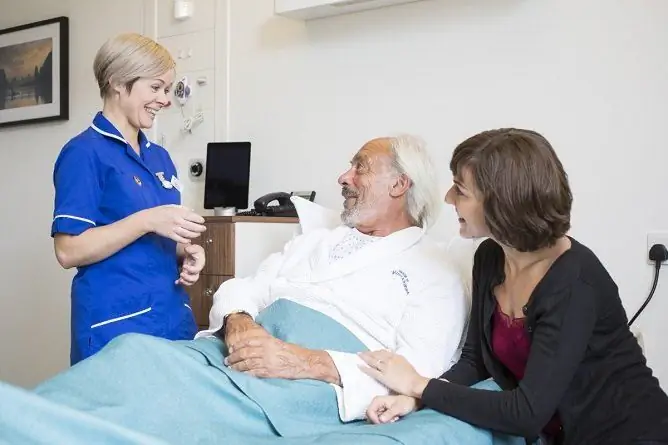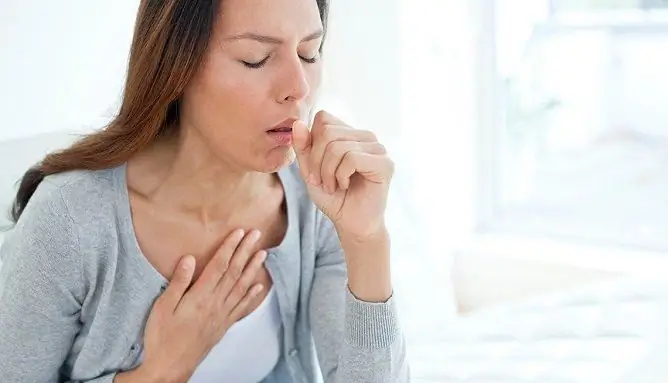- Author Rachel Wainwright [email protected].
- Public 2023-12-15 07:39.
- Last modified 2025-11-02 20:14.
Therapeutic exercises after a stroke in the hospital and at home
The content of the article:
- Gymnastics in the early recovery period
- Gymnastics in the late recovery period
- Gymnastics according to Bubnovsky
- Video
Gymnastics after a stroke is one of the leading activities of the rehabilitation program. Without it, it is difficult to expect a satisfactory effectiveness of the therapy. Constant stimulation of mental and physical activity prevents possible degradation of cognitive and motor functions.
A stroke is an acute violation of cerebral circulation, accompanied by the formation of a persistent neurological deficit. The disease often becomes the cause of patients' disability, their social maladjustment. Rehabilitation after a brain accident is aimed at restoring the impaired functions. It should be early (starts from the moment of stabilization of the patient's general condition) and quite active. In fact, rehabilitation measures should be performed around the clock.

Post-stroke rehabilitation should begin immediately after the patient's condition has stabilized.
Already in the first hours after a stroke, positional treatment should be actively carried out, and starting from 2-4 days, in addition to it, passive physical exercises begin to be used.
At the initial stages of stroke treatment, physical therapy is aimed at eliminating the existing disorders of motor functions, in the future, its goal is to form a compensatory stereotype in a person.
Gymnastics in the early recovery period
In the first few days after a stroke, patients are usually on strict bed rest. During this period, only positional treatment is permissible. It consists in the fact that the patient is turned over every 2-3 hours and his limbs are laid in the correct position. This reduces the risk of pressure ulcers and lung congestion.
As soon as the condition of the patients becomes stable, they begin to perform passive and respiratory gymnastics.
Passive movements in paralyzed limbs improve blood flow, stimulate metabolic processes, and prevent muscle memory loss. They allow you to normalize muscle tone and prepare them for further stress.
Approximate set of exercises:
- flexion and extension of the arms in the shoulder and elbow joints;
- flexion and extension of the legs in the knee and hip joints;
- movements in the small joints of the hand;
- movements in the ankle and wrist joints.
Passive exercises should be performed 15-20 repetitions at least 3-4 times a day. It is advisable to combine them with massage of the limbs (rubbing, pinching, tapping).
It is not uncommon for a patient to have a paralyzed left or right side after a stroke. To restore mobility, not only physical, but also mental gymnastics is recommended. Its essence lies in the fact that the patient performs various movements of the paralyzed limb in his imagination. Such psychological training stimulates the patient's brain, allows to restore the broken connections between neurons.
The main goal of breathing exercises is to improve the supply of oxygen to tissues, as well as to prevent congestive pneumonia. The following exercises are most often recommended for patients:
- inflating balloons;
- performing an exhalation through a cocktail straw compressed by the lips.
After a stroke, speech function is often impaired in patients. To restore it, it is necessary to start performing articulatory gymnastics as early as possible, conducted under the guidance of a speech therapist. It includes several sets of exercises for the lips and tongue.
Often in people who have suffered a stroke, asymmetry appears between the right and left sides of the face, associated with a violation of the contractility of facial muscles. Gymnastics after a stroke for the face can eliminate these disorders or reduce their severity. Thanks to this, the patient improves not only the appearance, but also the functions of speech, chewing and swallowing. Here is an approximate set of exercises:
- slowly part your lips in a deliberate smile;
- close lips as for a kiss and tighten them;
- raise and lower eyebrows;
- slowly open and close your eyes, without moving your eyebrows;
- open your eyes wide, linger in this position and slowly lower your eyelids;
- alternately winking with either the left or the right eye;
- wrinkle your nose and sniff noisily;
- take a deep breath, trying to tighten the wings of the nose as much as possible, then exhale slowly through the mouth.
Gymnastics in the late recovery period
Approximately 3 months after the stroke, with a favorable course of the rehabilitation period, the physical activity of patients is partially restored. They can already sit, stand and even walk, but still often note that the left or right arm and leg are not working well. To restore the impaired motor functions in this period, physical therapy should be actively used.

Hand gymnastics improves fine motor skills and restores broken connections between neurons
Before recovering "large" movements, it is important to improve fine motor skills with hand exercises. Their daily and repeated repetition contributes to the formation of new connections between neurons in the cerebral cortex to replace the lost ones, which in turn improves the general motor function of the limbs, and in addition, has a positive effect on cognitive abilities. The patient is offered to do modeling, drawing, folding mosaic figures, doing various crafts.
The following exercises should be performed daily from a seated position:
- movements of the eyeballs diagonally, right-left, from top to bottom;
- opening and closing the eyelids;
- rotation of the head from side to side;
- clenching and unclenching fists;
- rotation of the hands;
- stretching and lifting the feet.
It is very important to achieve coordinated execution of movements with the limbs of the left and right half of the body.
As the patient's physical condition improves, the movements in the sitting position become more amplitude (bringing and extending the shoulder blades, lifting the upper and lower extremities).
There are much more exercises for arms and legs that are performed in a standing position. In a hospital and a sanatorium, they are performed under the supervision of a physical therapy instructor, and at home - by a nurse or a relative. Gymnastics after a stroke for the legs and arms includes the following basic exercises:
- raising and lowering arms;
- circular rotation of the arms in the shoulder joints;
- turns of the body to the right and left;
- squats;
- side bends.
After a stroke, gymnastics for the arms and legs must necessarily include exercises for developing joints, preventing the formation of contractures. Examples of such exercises: raising on toes, bringing the hands behind the back to the lock, rotations with the hands, and so on.
You can ask the exercise therapy instructor to shoot a video of gymnastics after a stroke, which will detail the technique and show how to perform each exercise.
Stroke patients need daily cardiovascular exercise. The most effective cardio exercise for them is walking. Patients should take their first steps with the help of caregivers or relatives. Later, as motor activity and coordination of movements improve, they can walk independently or relying on additional devices (crutches, canes, ski poles).

Walking or jogging is an effective method of late post-stroke rehabilitation.
At the later stages of rehabilitation treatment, jogging may be recommended to patients, but only after a thorough medical examination and instrumental examination (electrocardiogram, echocardiogram, electroencephalogram).
Gymnastics according to Bubnovsky
Doctor of Medical Sciences Sergei Bubnovsky has developed a unique rehabilitation system for patients who have suffered a stroke. It includes:
- Physiotherapy exercises. All exercises are performed using special simulators. For each patient, the instructor develops an individual complex, taking into account the peculiarities of the existing disorders of motor function, general physical condition.
- Magnetic transcranial stimulation. Electrodes are applied to the scalp, which send magnetic impulses to the cerebral cortex. They activate areas of the cortex that are responsible for certain functions.
- Electromyostimulation. Electrodes are applied to the muscles of the paralyzed limb and fixed. Subsequently, electrical impulses are transmitted through them, irritating the muscles and forcing them to contract. This technique helps to strengthen the muscles, prevents the development of their atrophy.
- Intracellular stimulation. The patient is prescribed drugs that include certain trace elements and organic acids. Intracellular stimulation is especially effective for restoring impaired speech function.
- Treatment by position. After a stroke, the patient's paralyzed limbs take a certain position. With their prolonged immobility, contracture is formed, which is very difficult to correct in the future. In order to prevent this complication of stroke, it is necessary to put the limbs in certain positions that allow you to achieve maximum muscle relaxation.
- Paraffin applications. Thermal procedures contribute to the expansion of blood vessels, increased blood flow to the affected muscles, and activation of metabolic processes in them.
- Therapeutic massage. Improves metabolic processes by increasing blood circulation, normalizes impaired muscle tone.
Video
We offer for viewing a video on the topic of the article.

Elena Minkina Doctor anesthesiologist-resuscitator About the author
Education: graduated from the Tashkent State Medical Institute, specializing in general medicine in 1991. Repeatedly passed refresher courses.
Work experience: anesthesiologist-resuscitator of the city maternity complex, resuscitator of the hemodialysis department.
Found a mistake in the text? Select it and press Ctrl + Enter.






